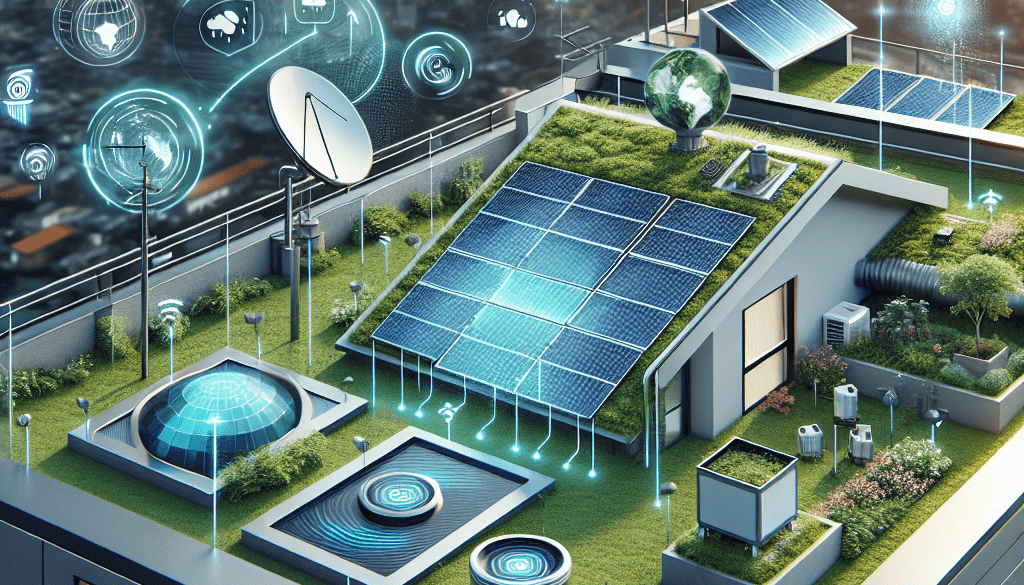
The intersection of roofing and technology brings about a revolution that’s both innovative and energy-efficient. Among these advancements, solar panels, sensors, and smart coatings are at the forefront, transforming the way we think about the humble roof.
Harnessing Solar Energy with Photovoltaic Panels
It’s impossible to discuss modern roofing without acknowledging the role of solar panels. Seamlessly integrating solar technology into roofing materials provides a dual benefit – protection from the elements and a source of renewable energy. The integration of photovoltaic technology into roofing systems is a smart move that pays dividends in reducing carbon footprints.
Solar roofing systems like Tesla’s Solar Roof have turned heads with their sleek design and efficiency. These systems incorporate solar cells directly into roofing tiles or shingles, creating a camouflaged, aesthetically pleasing solar energy solution. Unlike traditional solar panels that sit atop the existing roof, these integrated systems are the roof. They are designed to capture sunlight and convert it into electricity, ensuring that every ray that hits your home works for you. It’s an integration that blurs the line between construction and energy production, making the solar roof a paradigm of self-sustaining living.
The economic incentives for installing solar roofing are robust. With potential for government rebates and the decrease in solar panel costs, homeowners are seeing a quicker return on investment. The allure of decreasing electricity bills, and in some cases, selling excess electricity back to the grid, makes solar roofing an attractive proposition for the environmentally conscious and cost-savvy homeowner alike.
Innovative Sensors in Roofing Systems
Expanding on the smart roofing technology, the integration of sensors revolutionizes the way we monitor and maintain roofs. These compact yet robust devices play a pivotal role by providing real-time data on various aspects of a roof’s condition.
The significance of incorporating sensors into roofing systems lies in their ability to offer early detection of potential issues. By identifying problems before they become visually evident, proactive maintenance becomes feasible, preventing minor concerns from evolving into more extensive and costly repairs. This proactive approach is particularly advantageous for commercial buildings, where the sheer scale of roofing makes traditional manual inspections challenging. Sensors present a practical and efficient alternative, enabling seamless monitoring of the roof’s condition.
The applications of these sensors extend beyond the realm of roof health. They contribute to managing the internal environment of a building, leading to more intelligent climate control and enhanced energy efficiency. Through the analysis of external weather conditions and internal temperatures, smart roofing systems can optimize heating and cooling usage.
Consider a scenario where a sensor detects a subtle change in humidity levels, signaling a potential leak. In response, the system can trigger an alert, prompting timely intervention to address the issue before it escalates. This level of precision and responsiveness is a testament to the transformative impact of sensor technology on roofing solutions.
The interconnected nature of these sensors allows for a holistic approach to building management. The data collected can be integrated into broader building automation systems, fostering synergy between various components like lighting, HVAC, and security systems. This integration streamlines overall building operations, promoting a more sustainable and cost-effective approach to facility management.
The integration of sensors into roofing systems contributes to more efficient and sustainable building management. The ability to monitor environmental factors in real-time empowers property owners to make informed decisions, ensuring the longevity of their roofs and optimizing the overall performance of their buildings.
Smart Coatings: The Next Frontier
While solar panels and sensors pack a punch in smart roofing technology, smart coatings are the unsung heroes. These are specialized coatings applied to roofing materials to imbue them with added functionality. Reflective coatings that bounce back the sun’s rays, reducing the need for air conditioning, are one example of this smart technology at work. But the scope of smart coatings goes beyond mere reflection.
Imagine a roof that cleans itself or that can repair minor cracks and damages without human intervention. This is a direction smart coatings are headed. The magic lies in the science behind these coatings – some are designed to be hydrophobic, repelling water and dirt, while others might leverage micro-capsules that release repairing agents when damage is detected.
Not only do these coatings extend the life of the roof by protecting the underlying materials, but they also contribute to a reduction in maintenance costs and effort. As research in nanotechnology and material science advances, the potential for these smart coatings is boundless, with exciting possibilities like energy-storing and air-purifying functions on the horizon.
Connectivity for Comprehensive Control
What ties all these smart roofing elements together is the growing trend towards a connected home. With the Internet of Things (IoT), it’s becoming increasingly common for household systems to communicate with one another. Roofs equipped with solar panels, sensors, and smart coatings can all feed into a centralized management system, allowing homeowners to monitor and control their roofing system with the touch of a button.
The integration of smart roofing technologies not only addresses immediate needs like energy efficiency and durability but also sets the stage for adaptability in the face of climate change and evolving environmental policies. It’s a clear sign that the industry is responding to current demands and anticipating future trends.
As we embrace these technological advancements, there’s an undeniable shift in the relationship we have with our homes. Roofs are no longer just about shelter; they’re about smart living, energy production, and proactive management of our living spaces. With each technological stride, roofs are becoming an active participant in the energy ecosystem of our homes.
With solar panels that cut down on fossil fuel dependence, sensors that prevent costly damages, and smart coatings that conserve energy and self-maintain, smart roofing technology isn’t just changing roofs – it’s reshaping our homes’ future. The convergence of these technologies signals a paradigm shift towards more sustainable living, and it’s happening from the top down.